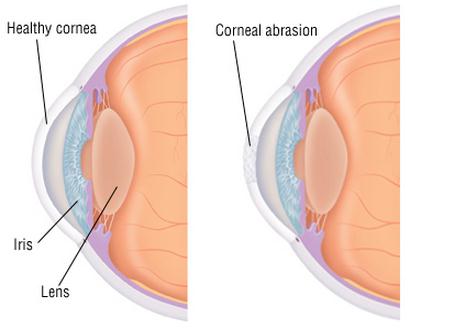Corneal Abrasion – Treatment, Symptoms, Causes, Diagnosis
What is Corneal Abrasion?
Contents
Corneal abrasion is the medical condition that involves the loss of the epithelial surface layer of the eye’s cornea. The corneal abrasion, which can be either large or small, is a common kind of eye injury that is sometimes neglected. This is due to a disruption of the corneal epithelium integrity or the fact that the surface of the cornea has been denuded or scraped away as a result of external physical forces.
On the one hand, other experts define corneal abrasion as a scratched, torn, or scraped corneal epithelial layer (the surface area of the cornea) which is caused by injury from protruding objects, damage from contact lens or flying glass. On the other hand, others would define corneal abrasion as a loss of tissue from the corneal epithelium which can be either deep or superficial due to trauma to the eye. It comprises a defect in that area with or without breach of Bowman’s layer.

Corneal Abrasion Symptoms
People who have recently suffered an eye injury are susceptible to corneal abrasion. The following are symptoms which may be experienced by people who suffer from corneal abrasion:
- Eye pain (especially when the eye is exposed to bright light)
- Teary eyes
- Distortion or blurring of vision
- Spasm in the eye muscle
- Excessive squinting
- Eye redness
- Inability to open the affected eye
- Mild photophobia
- Foreign body sensation
- Edema in the epithelial area
- Swollen eyelids
- Mild anterior chamber reaction
- Crust build-up
- Headache
People with corneal abrasion are often unaware that they have this condition. Usually the most common symptoms associated with corneal abrasion can be felt and seen after the eye injury.
Corneal Abrasion Causes
People may experience corneal abrasion due to the following causes or reasons:
- Corneal injury
- Walking into a tree branch
- Corneal dystrophy like lattice corneal dystrophy
- Trapped foreign object under the upper eyelid
- Penetration of projectile particles
- Finger poking
- Excessive eye rubbing
- Hot cigarette ash in eye
- Exposure to sunlight or ultraviolet light
- Eye infection
- Object blown into, or poked in, the eye
- Sport injuries
- People who have undergone surgical procedure that required general anesthesia
- Over-prolonged contact lens wear
Corneal Abrasion Diagnosis
People who are suspected to have corneal abrasion are usually recommended to undergo tests like:
- Physical examination
- Medical historical examination
- Slit lamp examination
- Visual acuity examination
- Fluorescein staining examination (confirmative diagnostic test)
- Orbit CT scan
Corneal Abrasion Treatment
Generally a person who suffers from a small corneal abrasion requires no treatment. However, large abrasions require treatment. Minor abrasion or scratches will generally heal in two days. Treatment for corneal abrasion includes:
Medical treatment
The medications usually prescribed for people who suffer from corneal abrasion include analgesics and antibiotics which can be through ointment or eye drops. Normally, corneal abrasion heals rapidly. Hence, there is a need to manage the corneal abrasion medically to prevent corneal infection. Another example of medication that is used to treat corneal abrasion is cyclopegic in topical form which reduces the pain and provides comfort to the person.
The use of contact lens or eye patch
Sometimes, the physician will place an eye patch or contact lens to aid in the relief of the discomfort and also to accelerate the recuperation stage of the affected eye.
Home treatment
For minor kinds of corneal abrasion, home treatments can be done. Examples of home treatments are as follows:
- Rinse affected eye with running water
- Avoid rubbing the eye
- Use moist compresses to relieve pain
- Avoid contact lens wear until otherwise told by a licensed physician
Corneal abrasion surgery
In cases when corneal abrasion leads to opacification, ulcer, or scarring, medical treatment and evaluation are needed from a cornea specialist. Surgical procedure is done when the person with corneal abrasion shows inadequate improvement with the given or provided medical treatment. Examples of surgical procedure are:
- Kronlein-Burke surgical approach or lateral orbitotomy
- Cladwell Luc surgical approach or transantral approach
Corneal Abrasion Complications
The complications that are associated with people who suffer from corneal abrasion are as follows:
- Infiltration of the cornea
- Trapped foreign body in eye
- Allergic conjunctivitis (due to an adverse effect of the antibiotic treatment)
- Eye pain
- Photophobia
- Eye redness
- Blepharospasm
Despite the fact that corneal abrasion can normally heal within 7 days, complications do arise. However, according to conducted studies, the complications mentioned here are rare. Aside from the ones mentioned, there are also the intraoperative kind of complications which may arise from surgical treatment.